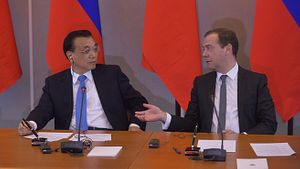Chinese premier Li Keqiang capped his tour through the One Belt, One Road’s hinterland with a stop in St. Petersburg, Russia to meet with his Russian counterpart Dmitry Medvedev. The 21st regular meeting of the Russian and Chinese heads of government came with the usual raft of agreements and memorandums.
Ahead of Li’s visit to St.Petersburg, Medvedev gave an interview with China Central Television. Trade was a big topic of discussion, particularly free trade, the WTO, and protectionism. It’s hard not to read between the lines and see the United States and the Trans-Pacific Partnership (as well as the Transatlantic Trade and Investment Partnership (TTIP), a free trade agreement under negotiation between the United States and Europe).
“Remember how much time we spent in the waiting room, both Russia and China?” Medvedev said. “No country spent more time waiting to be admitted to the WTO than our countries.”
He went on:
And now they are telling us, “you know, the WTO is obsolete, it’s time to create new trade alliances.” We disagree… Various protectionist solutions often conceal a desire to destroy the World Trade Organisation and to replace it with something else.
He later referenced the two U.S.-led agreements specifically, noting “Let other countries go for such economic projects and integration, and we will develop our own integration projects.”
Medvedev thus bolstered the idea of synergizing the Eurasian Economic Union, officially established on January 1, 2015, with OBOR. Touting the EEU countries as “enormous transit zones” Medvedev depicted the union as a natural partner for the Chinese.
Russia says it hopes to grow trade with China to $200 billion in the next three to seven years, with 2020 mentioned as a target. This may be easier said than done. In 2014, trade turnover between the two countries neared $100 billion, but the trend since has been downward. According to the Chinese, in the first three quarters of 2016, trade turnover has amounted to just over $50 billion. The source of the drop seems to be dwindling Russian demand for Chinese imports. Among the initiatives discussed between the two leaders was a preferential trade agreement. “This is a complicated path, it is necessary to act carefully, especially when it comes to changing the tariff policy, range of tariffs in a number of cases,” Medvedev cautioned.
That said, the two countries have made no small show of trying to expand ties. According to TASS, Medvedev said, “today it is difficult to name a sector where Russia and China do not cooperate.” And that much is true. Among the agreements made was the forming of a joint Russia-China Venture Fund (RCVF) aimed primarily at helping Russian tech companies and start-ups make it in the Chinese market. According to TASS some areas of focus will be “technology in the financial sector, big data, cloud technologies, biotechnology, etc.”
There was also a possible financing agreement between Gazprom and China Development Bank (CDB); an agreement between Vnesheconombank (VEB) and CDB enabling the Russian bank to borrow a billion dollars (six billion yuan) over 15 years to invest in various projects; and a deal between Rosneft and Bejing Gas Group for the sale of a 20 percent stake in Verkhnechonskneftegaz for $1.1 billion, the Rosneft subsidiary is exploring oil and gas fields in Eastern Siberia.

































